Löhne
![]()
The title of this article is ambiguous. For the German botanist see Cornelia Löhne.
Löhne [![]()
![]() ˈløːnə] (Low German: Loihne, Loine) is a medium-sized town in the northeast of the German state of North Rhine-Westphalia, located about 25 km northeast of Bielefeld. With about 40,000 inhabitants, it is the third-largest municipality by population in the eastern Westphalian district of Herford. Löhne is an important location for the furniture industry and therefore calls itself the world city of kitchens. It lost its former function as an important railway junction in the second half of the 20th century.
ˈløːnə] (Low German: Loihne, Loine) is a medium-sized town in the northeast of the German state of North Rhine-Westphalia, located about 25 km northeast of Bielefeld. With about 40,000 inhabitants, it is the third-largest municipality by population in the eastern Westphalian district of Herford. Löhne is an important location for the furniture industry and therefore calls itself the world city of kitchens. It lost its former function as an important railway junction in the second half of the 20th century.
Geography
Geographical location
Löhne is situated in the hilly landscape of the Ravensberger Mulde in the lower Weserbergland. From many points in the town you can make out the chain of the Wiehengebirge to the north, about 10 km away. The nearest major cities are Bielefeld, 25 km to the southwest, and Osnabrück, 50 km to the west. The capital of Lower Saxony, Hannover, is about 80 km to the east. Neighbouring towns and communities are Hüllhorst in the north, Bad Oeynhausen in the east (both in the district of Minden-Lübbecke), Vlotho in the southeast, Herford in the south, Hiddenhausen in the southwest and Kirchlengern in the west.
Nature area
Löhne is divided into three natural subdivisions. Centrally in west-east direction runs the 1-2 km wide Werreniederung, which is part of the Else-Werre-Niederung. Coming from the south, the Werre first forms the south-western city boundary, then enters the valley, turns its course to the east here (after joining the Else at the border to Kirchlengern) and crosses the city area in the middle. At its transition to Oeynhausen territory, Loehne's lowest point is found at 48 m above sea level. To the north, the town is part of the Quernheimer Hügelland, where heights of around 105 m are reached in the west on the Obernbecker Egge and in the north at the district of Grimminghausen. For the most part, however, the area lies at 55-80 m. In the south there is the steeper Oeynhausen hill country. Here the terrain is mostly above 80 m, it rises to 177 m above sea level on the Dornberger Heide near the border point to Vlotho and Herford.
The most important stream flowing into the Werre from the north is the Rehmerloh-Mennighüffer Mühlenbach in the district of Ulenburg. The most important tributary in the south is the Mittelbach, which rises at the Steinegge in Vlotho.
Among the numerous small still waters of Loehne are the Fichtensee and the Blutwiesensee.
The predominant climate is the Atlantic maritime climate. For more precise climate data, compare the long-term averages (1971-2000) for Herford, about 15 km away. The data for Löhne should hardly deviate from this due to its similar location in the Werre Valley.
see also: Climate in Ostwestfalen-Lippe
Extent and use of the urban area
Löhne has an area of just under 60 km², extending 9 km in a north-south direction and 7 km in an east-west direction. The city is densely populated and also highly urbanized. It is part of the conurbation in northern East Westphalia-Lippe, which extends from the district of Gütersloh via Bielefeld and Herford to Minden. The district of Gohfeld has largely grown together with the settlement area of Bad Oeynhausen. The predominantly fertile soils are used intensively for agriculture, mainly for grain, maize and rape cultivation. The forest area is small. The following table shows the exact land use.
|
| Settlement and transport area | Agricultural land | Forest area | Other open spaces |
| Area in hectares | 2121 | 3405 | 308 | 11 |
| Percentage of total area | 35,7 % | 57,3 % | 5,2 % | 1,8 % |
City breakdown
Löhne is divided into the five districts of Gohfeld, Löhne-Ort, Mennighüffen, Obernbeck and Ulenburg, which date back to the independent rural communities that existed until 1969. Löhne, which gave its name to the town and was an independent municipality until 1968, was originally intended as a stopping point when the Cologne-Minden railway was built in 1847, but the planned station was built further east, retaining the name "Löhne", in Gohfeld territory. The settlement that formed around the station is still unofficially referred to as "Löhne-Bahnhof" and was defined as the town centre after the town was formed.
Ulenburg along the Mühlenbach is by far the smallest district with only about 500 inhabitants and has no settlement core of its own.
| ||||||||||||||||||||||||||||||
City centre
The town of Löhne, which has grown together from formerly independent communities, lacks a typical town centre. In the district of Löhne-Bahnhof, which is designated as such, there is a small commercial centre with a pedestrian zone, which has so far been able to develop only little further between the competition from the surrounding medium-sized centres of Bad Oeynhausen, Bünde and Herford. The other local centres of Löhne as well as newly built business centres in the outskirts also form strong inner-city competition.
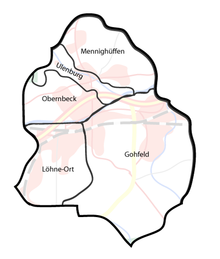
City breakdown

Werre
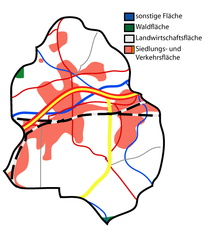
Land use
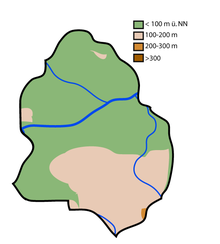
Topography of the urban area
Population
Population development
The figures before 1969 summarize the values of the previously existing administrative units. Their area differs slightly from that of today's city area.
|
|
|
Language
High German is the colloquial language in Löhne. A hundred years ago it was still a foreign language, known only from school and church services and used only in dealings with official bodies. Among themselves, the people of Löhne spoke only Platt, i.e. Low German. Within three generations it almost died out in Löhne, because after the First World War it was considered peasant and backward. In addition, with the many East German refugees after 1945 and later immigrants, communication was only possible in High German. For some time now, attempts have been made to maintain the linguistic heritage through adult education courses and occasional newspaper articles and plays in Platt.
In Löhne, Ravensberger Platt was spoken, a variant of East Westphalian, which in turn belongs to the language area of Westphalian. Essential features of the latter were also found in the Löhne language, such as many diphthongs, the muffled o developed from the long Middle Low German a, the stretching of the short Middle Low German a and the preservation of the inlaut sk. Examples:
- High German: eat, cook; evening, bowl, sleep; make, dig, thing; fish, wash, German
- Löhner dialects: iaden, koaken/kuaken; Obend, Schole, schlopen; maken, grawen, Ssake; Fisk, wasken, duitsk
- Gohfeld peculiarities: eden, koken
As already partly evident, even such a manageable area as Löhne was linguistically not uniform, there were noticeable, especially phonetic differences between the various places. One can distinguish three sub-areas: Gohfeld, the area north of the Werre (Mennighüffen, Obernbeck, Ulenburg) and Löhne-Ort. The correspondence to the three oldest parishes is obvious. In the centrally located and quite young Löhne-Bahnhof the linguistic zones of influence may have overlapped and mixed.
Below are a few representative words to illustrate the differences:
- High German: break, nose, oven, brother, go, learn, we came, farmer, expensive, goose, short.
- Gohfeld: breken, Nesen, Oben, Broer, john, lehrn, wui koimen, Buer, düer, Jäos, kocht.
- North of the Werre: briaken, Niasen, Oaben, Broer, gohn, leihern, wui keimen, Buer, duier, Gäos, koat.
- Löhne place: briaken, Niasen, Uaben, Bräoer, gäohn, leihern, wui keimen, Biuer, duier, Gäos, kuat.
Religions
Precise religious statistics for Löhne are not published. However, the Protestant confession is dominant, to which the population had belonged almost without exception since the Reformation until the 20th century. It was not until the refugees from the East that a larger number of Catholics arrived. The religious composition of Loehne became more colourful, as elsewhere, through the subsequent immigrant groups, and there were also church resignations. The religious affiliation of Loehne's pupils can serve as an indication of the exact distribution. Of these, 68% were Protestant, 8.3% Catholic, 8.4% Muslim, 7% adherents of other denominations and 8.3% non-denominational in the 2002/2003 school year.
Löhne is home to the five Evangelical Lutheran parishes of Gohfeld, Löhne-Ort, Mennighüffen, Obernbeck and Siemshof, which belong to the Evangelical Church of Westphalia, as well as the Evangelical Free Church parishes of "Kreuzkirche" and "Christliche Gemeinde Mennighüffen". The Loehn Catholics of the Archdiocese of Paderborn are organised in the parish of St. Laurentius, the members of the New Apostolic Church belong to the congregation in Bad Oeynhausen.
Islam is represented by a mosque and a cultural centre, and the Islamic Association and the Association of Islamic Turkish Workers also provide prayer rooms.
Yazidis are also represented. The Society of Yezidi Academics has acquired Ulenburg Castle.
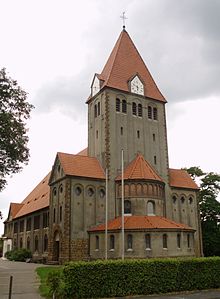
Christ Church Obernbeck
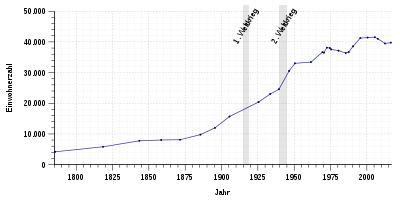
Population development in Löhne from 1785 to 2016
Search within the encyclopedia